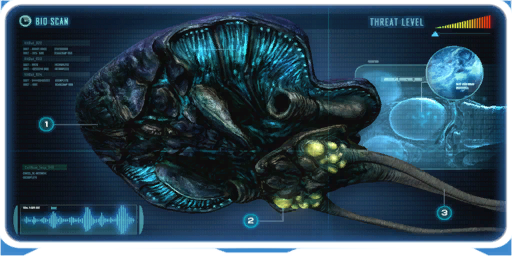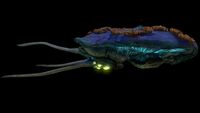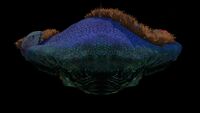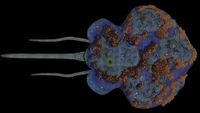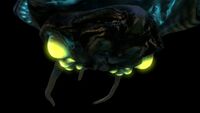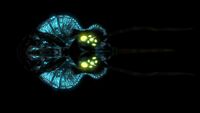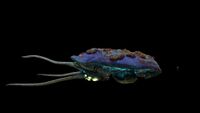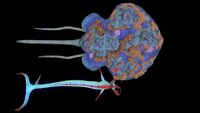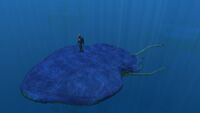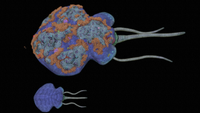Reefback Leviathan: Difference between revisions
Apotheosis3 (talk | contribs) |
(Adding categories) |
||
| Line 192: | Line 192: | ||
[[Category:Underwater Islands]] |
[[Category:Underwater Islands]] |
||
[[Category:Leviathan Class]] |
[[Category:Leviathan Class]] |
||
[[Category:Creatures with variants]] |
|||
Revision as of 22:46, 19 January 2021
<title source="title1" style="font-weight:bold; text-align:center;"> <default>Reefback Leviathan</default> </title> <image source="image1"></image> <label>Category</label> <label>Tab</label> <label>Description</label> <label>Affiliation</label> <format></format> <label>Age</label> <label>Description when cooked</label> <label>Description when cured</label> <label>Inhabit</label> <label>Attitude</label> <label>Health</label> <label>Damage</label> <label>Adult Damage</label> <label>Juvenile Damage</label> <label>Drops</label> <label>Perks</label> <label>Biome</label> <label>Active During</label> <label>Size</label> <label>Length</label> <label>Bioreactor</label> <label>DNA</label> <label>Voice Actor</label> <label>Debug Spawn</label> <format>
- {{#explode:reefback reefbackbaby||0}}
- {{#explode:reefback reefbackbaby||1}}
- {{#explode:reefback reefbackbaby||2}}
- {{#explode:reefback reefbackbaby||3}}
- {{#explode:{{{item_id}}}||0}}
- {{#explode:{{{item_id}}}||1}}
- {{#explode:{{{item_id}}}||2}}
- {{#explode:{{{item_id}}}||3}}
- {{#explode:{{{debugspawn2}}}||0}}
- {{#explode:{{{debugspawn2}}}||1}}
- {{#explode:{{{debugspawn2}}}||2}}
- {{#explode:{{{debugspawn2}}}||3}}
The Reefback Leviathan is a passive leviathan class fauna species. It is the second largest passive life form, and ties with the Sea Dragon Leviathan for second largest creature overall.
Appearance
The Reefback is massive in size, with most of the creature's body being comprised of a thick, dark-blue carapace with a rounded, triangular front, and a relatively small body concentrated in the posterior. Attached to its main body are three long whip-like tentacles.
An adult Reefback has patches of teal-colored coral and brown-colored grass growing across its carapace, befitting its name, while the younger ones lack this trait. The carapace has a slightly bright blue dotted pattern across towards the back. Beneath its carapace, it is dark green with light blue bioluminescent stripes on the sides and in the middle. On either side of its body are eight yellow bioluminescent bulbs. The purpose of these is unknown, though the data bank entry notes a visual similarity to the Gasopod algae gland. They serve an unknown function in the digestive system. Two siphon-esque structures that constantly expand and retract as the creature moves are located next to these bulbs.
Behavior
The Reefback drifts slowly and gently around the open waters of many biomes, mostly seen swimming in pods of more than two. It rarely adjusts its current altitude, unless bumped against obstacles.
Juvenile Reefbacks are a quarter the size of an adult. They can often be found with adults in certain locations.
The Reefback will frequently emit a range of echoing, low-frequency calls. They will only emit these calls if there are other Reefbacks nearby. This suggests that these calls are a form of communication, as opposed to echolocation.
When Reefbacks are exposed to damage, their tentacles will wave quickly and they will move slightly faster for a brief period. When killed, their models and hitboxes completely disappear however the flora on their backs stay and fall towards the sea floor.
Mini-ecosystem
Adult Reefbacks can support mini-ecosystems on their back. These ecosystems include many types of flora and coral, along with other small fauna swimming in the vicinity of the gentle giants. Some caution should be taken when approaching Reefbacks, as Tiger Plants often make their homes on their backs. Adult Reefbacks often have barnacles growing on their back. These barnacles are Harvesting Nodes and can be broken to reveal resources, similar to limestone, shale, or sandstone outcrops. Currently, they only drop two resources: Silver Ore and Copper Ore. Copper ore is the most frequent resource to find.
<tabber> Fauna=
- Biter
- Bladderfish
- Boomerang
- Eyeye
- Holefish
- Hoopfish
- Hoverfish
- Peeper
- Reginald
- Shoal of Fish
- Spadefish
|-| Flora=
- Acid Mushroom
- Blood Grass
- Furled Papyrus
- Regress Shell
- Rouge Cradle
- Spotted Reeds
- Tiger Plant
- Veined Nettle
- Violet Beau
- Writhing Weed
|-| Coral=
|-| Harvesting Node=
</tabber>
Energy Value
Data Bank Entry
|
This vast lifeform is in excess of 30m long and has been designated leviathan class. Fortunately it feeds exclusively on plankton-like lifeforms in the water. 1. Chitinous Shell: 2. Enzyme Pods: 3. Local Microcosm: 4. Lifecycle: Assessment: Harbors plants, small fish and metal-rich barnacles |
Gallery
<tabber> Screenshots=
Size comparison between an adult Reefback and the Player
Size comparison with a Reaper Leviathan
A Reefback above the Blood Kelp Zone
|-| Concept Art=
</tabber>
Trivia
- Schools of Bladderfish and Holefish can only be found near Reefbacks.
- Reefbacks are capable of transporting the player when near the surface.
- Juveniles can be found infected with Kharaa , whereas the adults can not.
- Reefbacks were initially intended to submerge themselves in sandy areas. Increased activity around them would have made them rise in search of a peaceful place to rest.[1]
- Another intended interaction would've been that the player could grab hold of a Reefback's tentacles to hitch a ride or hide on their plant-covered backs to hide from predators.[2]
- Reefbacks were formerly much smaller than they currently are, and had the same texture that is currently given to juvenile Reefbacks.
- The game refers to Reefbacks as herbivores, yet the data bank entry states that they are planktivorous.
- The underside of a Reefback greatly resembles that of the Combine Gunship from the game Half Life 2.
- Reefbacks will travel at 0.5 meters per second.
References
Lua error in package.lua at line 80: module 'Dev:Navbox' not found.





